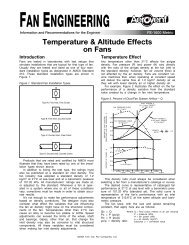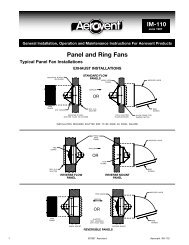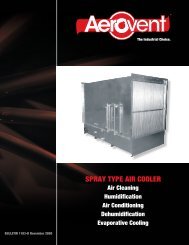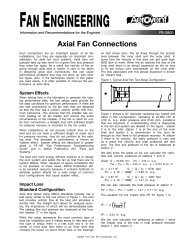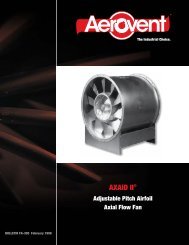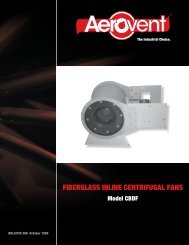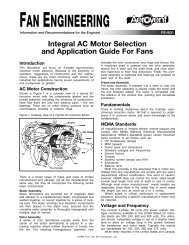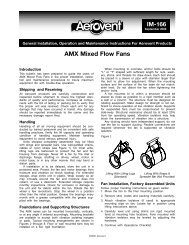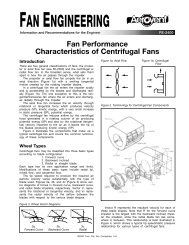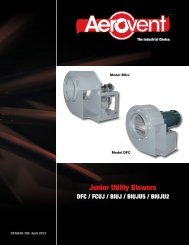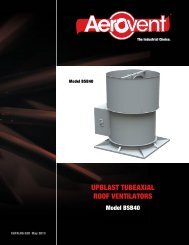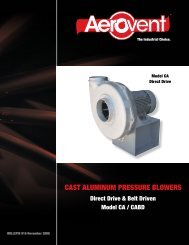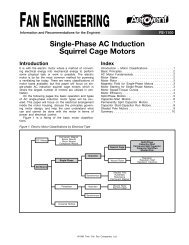MH INDUSTRIAL EXHAUST FANS - Aerovent
MH INDUSTRIAL EXHAUST FANS - Aerovent
MH INDUSTRIAL EXHAUST FANS - Aerovent
You also want an ePaper? Increase the reach of your titles
YUMPU automatically turns print PDFs into web optimized ePapers that Google loves.
Dust Collecting & Pneumatic Conveying<br />
Wherever material is airborne, the fan must provide the energy<br />
to move the material. In small concentrations this is negligible,<br />
but in most conveying systems it is important. It is reflected<br />
as an increased resistance. Chart A gives the ratio of friction<br />
loss of the conveying system to the same system handling<br />
clean air<br />
The material conveying capacity of a system varies as the<br />
square of the velocity since it is a function of the velocity<br />
pressure. The economics of a given installation determine<br />
whether the minimum or a higher velocity shall be used.<br />
It is sometimes thought that a larger fan is naturally better<br />
than a smaller one. This is far from correct, since material<br />
is just as liable to settle in a fan as in a duct. If the inlet and<br />
outlet velocities of a fan are at least as high as the minimum<br />
conveying velocity, no settling should occur in the fan.<br />
Abrasion & Corrosion<br />
Certain materials can be highly abrasive by nature and,<br />
depending on the concentration and properties of the<br />
abrasive, can greatly affect the selection of the type of fan<br />
and wheel design.<br />
Proper fan and wheel selection alone may not satisfy<br />
the abrasive conditions. Special abrasive, impact, corrosion,<br />
and heat resistant materials or coatings may be required to<br />
further increase the life of the fan. Although <strong>Aerovent</strong> has<br />
the experience to recommend various materials or coatings to<br />
increase the life of the product, it must be recognized that to<br />
date no materials have been discovered that completely resist<br />
these conditions. Therefore, resistance to them is one of<br />
degree only.<br />
Chart A. Friction For Conveying<br />
FRICTION MULTIPLIER<br />
1.8<br />
1.7<br />
1.6<br />
1.5<br />
1.4<br />
1.3<br />
1.2<br />
1.1<br />
MULTIPLY FRICTION<br />
FOR CLEAN AIR<br />
BY MULTIPLIER<br />
1.0<br />
0 10 20 30 40 50 60 70 80 90 100<br />
CUBIC FEET OF AIR PER MINUTE PER POUND OF MATERIAL<br />
Chart B. Average Velocities & Air Volumes<br />
For Conveying Materials<br />
CONVEYING VELOCITY IN FT. PER MIN.<br />
6500<br />
6000<br />
5500<br />
5000<br />
4500<br />
4000<br />
3500<br />
3000<br />
CU. FT. OF AIR PER LB. OF MATERIAL<br />
100<br />
90<br />
80<br />
70<br />
60<br />
50<br />
40<br />
VALUES ARE FOR BULK<br />
MATERIALS OF AVERAGE<br />
SURFACE CONDITION.<br />
WEIGHTS ARE<br />
NOT DENSITIES.<br />
CONVEYING VELOCITY FT. PERMIN.<br />
CU. FT. OF AIR PER LB. OF MATERIAL<br />
30<br />
5 10 15 20 25 30 35 40 45 50<br />
BULK WT. OF MATERIALS IN LBS. PER CU. FT.<br />
Spark-Resistant Construction<br />
Described below are three classifications as defined by AMCA<br />
Standards for spark resistant construction.<br />
Type<br />
Construction Details<br />
“A” All parts of the fan in contact with the air or gas<br />
being handled shall be made of nonferrous material.<br />
Steps must also be taken to ensure that the impeller,<br />
bearings, and shaft are adequately attached and/or<br />
restrained to prevent a lateral or axial shift in these<br />
components.<br />
“B” The fan shall have a nonferrous impeller and<br />
nonferrous ring about the opening through which<br />
the shaft passes. Ferrous hubs, shafts, and hardware<br />
are allowed provided con-struction is such that a shift<br />
of impeller or shaft will not permit two ferrous parts<br />
of the fan to rub or strike. Steps must also be taken<br />
to ensure that the impeller, bearings, and shaft are<br />
adequately attached and/or restrained to prevent a<br />
lateral or axial shift in these components.<br />
“C” The fan shall be so constructed that a shift of the<br />
impeller or shaft will not permit two ferrous parts of<br />
the fan to rub or strike.<br />
NOTES:<br />
1. No bearings, drive components or electrical devices shall<br />
be placed in the gas stream unless they are constructed or<br />
enclosed in such a manner that failure of that component<br />
cannot ignite the surrounding gas stream.<br />
2. The user shall electrically ground all fan parts.<br />
3. For this standard, nonferrous material shall be any<br />
material with less than 5% iron or any other material with<br />
demonstrated ability to be spark resistant.<br />
4. The use of aluminum or aluminum alloys in the presence<br />
of steel that has been allowed to rust requires special<br />
consideration. Research, by the U.S. Bureau of Mines and<br />
others, has shown that aluminum impellers rubbing on rust<br />
steel may cause high intensity sparking.<br />
The use of the above standard in no way implies a guarantee<br />
of safety for any level of spark resistance. Spark resistant<br />
construction also does not protect against ignition of explosive<br />
gases caused by catastrophic failure or from any airstream<br />
material that may be present in a system.<br />
11 <strong>Aerovent</strong> Bulletin 705



